Low Back Pain After Lifting: Common Causes and Treatment
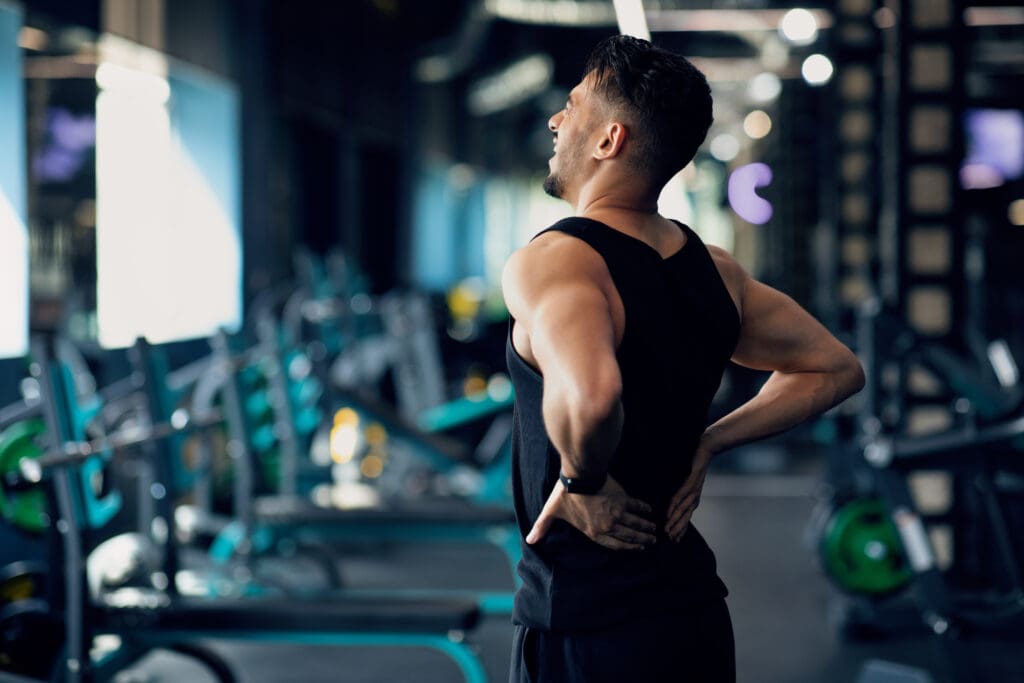
So, you’re a lifter or athlete experiencing low back pain and you’re wondering what to do?
The first step- don’t freak out. Back pain is like the common cold these days- almost everyone will experience it at some point. That doesn’t mean you have to live with it though.
Take some deep breaths and read more about common causes of back pain and next steps to take. Remember, no matter what’s causing your back pain, a physical therapist can help treat it to reduce your pain and improve function.
We always recommend if you’re experiencing back pain to schedule an evaluation with a physical therapist. Why wait? While you can self-treat at home, you’ll save yourself time and effort by going straight to an expert who will guide you through the rehabilitation process.
You also do not need a doctor’s referral to schedule an initial evaluation with a physical therapist unless you have specific insurances such as Medicare or Connecticare. If you’re not sure, you can submit an appointment request here. Our Patient Services Coordinators will help you navigate your insurance.
Common Causes of Back Pain in the Gym
The truth is that pain is complex and can be a result of multiple causes and factors. Most injuries occur due to an acute injury, overuse, or an underlying condition.
Acute Injuries
Acute injuries occur during exercise, physical activity, or doing something like lifting a heavy box. If you feel sudden intense back pain and cannot identify a physical cause, you should see your physician.
You should also see your doctor if you experience the following symptoms:
- Severe abdominal pain
- Fever
- Loss of control of bladder and bowels
If you feel or hear a pop in your low back while working out, don’t panic. If there’s no pain associated with the pop, you might’ve just released air bubbles in the joints of your low back just like cracking your knuckles. A pop could also indicate an injury.
If you can pinpoint something that caused the injury, like a poorly executed lift, and are experiencing back pain, here are some common causes you might be experiencing.
1. Ligament strain or muscle tear
A muscle strain or ligament sprain are the most common causes of back pain. The low back supports the weight of the upper body and twists, bends, and moves around. A muscle strain is the when the muscle fibers are stretched or torn. A ligament sprain is when ligaments (tough bands of tissue that hold joints together) are torn.
Signs and Symptoms:
- Low back pain that you might feel in buttocks but not down legs
- Low back stiffness and restricted range of motion
- Muscle spasms during intense activity or rest
- Pain typically lasts no more than 10-14 days
Treatment:
You might expect us to say rest, but that’s not necessarily the case. Bed rest can actually increase discomfort and stiffness, while movement can help the body heal and limit muscle loss. Mild to moderate pain is often treated with nonsteroidal anti-inflammatory (NSAIDs) medication.
Exercises to limit while experiencing a low back sprain or strain:
- Crunches/sit-ups
- Heavy lifting
- High impact activities such as jumping or running
- Ab exercises where both legs are in the air (such as flutter kicks)
However, everyone is different. You might be able to tolerate one of the exercises listed above. If an exercise flares up your low back pain, limit it or modify it until pain is resolved.
Exercises to do while experiencing a low back or strain:
- Swim
- Glute Bridges
- Cobra pose
- Deep core strengthening exercises, such as pelvic tilts
While exercising, you should always focus on form and prioritize good movement over lifting more weight or speeding through your workout. When dealing with a low back injury, it’s especially important to slow down your movements and focus on technique.
2. Lumbar Disc Injury
You might’ve heard someone say they “slipped a disc.” The disc refers to a cushiony disc in between the vertebrae (the bones in your spine). The disc consists of two parts: an inner jelly-like substance (red) and an outer tough, flexible ring (blue).
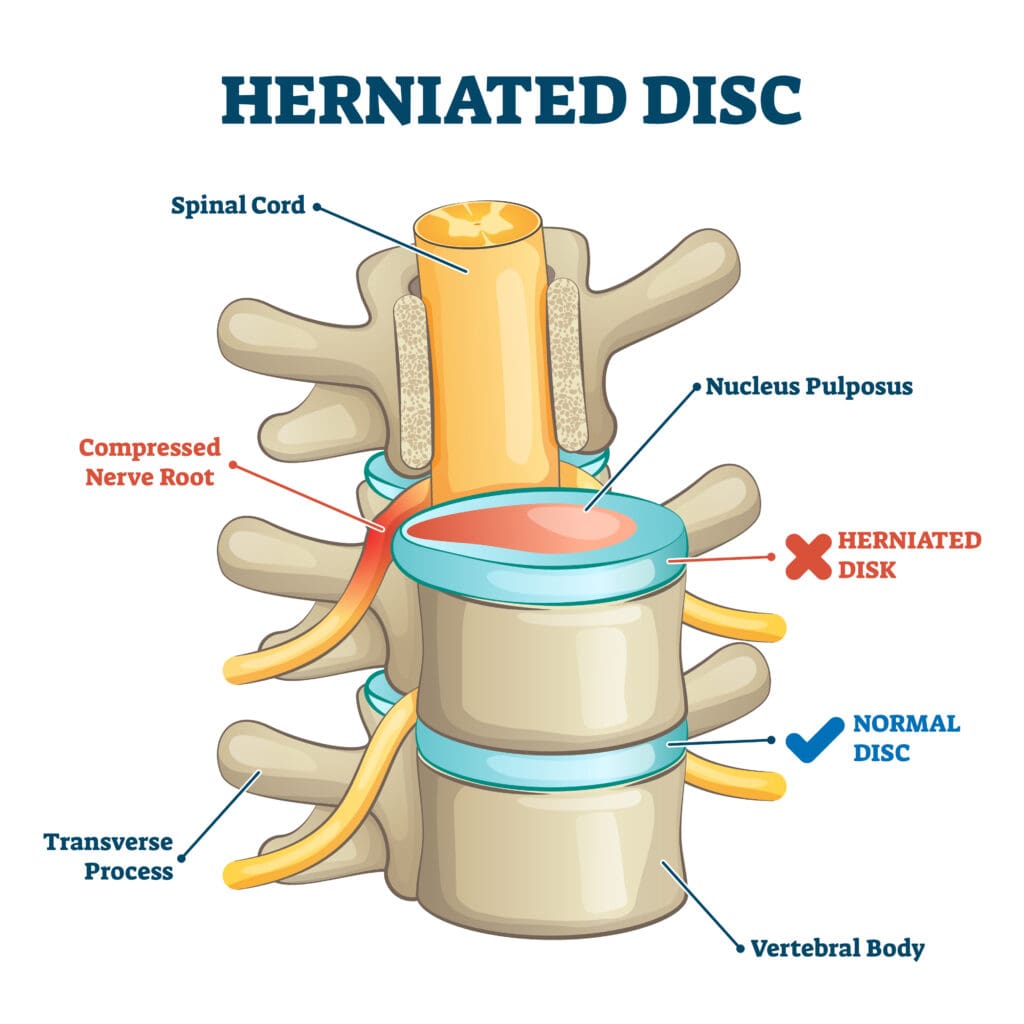
A bulging disc is when the inner jelly-like substance pushes against the outer ring. This pressure can cause lower back pain. The jelly-like substance can also protrude all the way through the other ring, which is when it is considered a herniated disc. This can cause pressure on the spinal cord and nearby nerve roots. When the nerve roots are irritated, this can cause symptoms like pain, numbness, or weakness down the legs.
A herniated disc can occur due to an acute injury such as improper lifting, but it can also occur due to disk degeneration that occurs with aging and general wear and tear. Normal aging increases the risk of herniating a disc.
Signs and Symptoms:
- Low back pain that can be intense, often worse after long periods of sitting
- Numbness, weakness, pain, or tingling down one or both legs
- Increased pain with flexion-based activities such as bending
Treatment
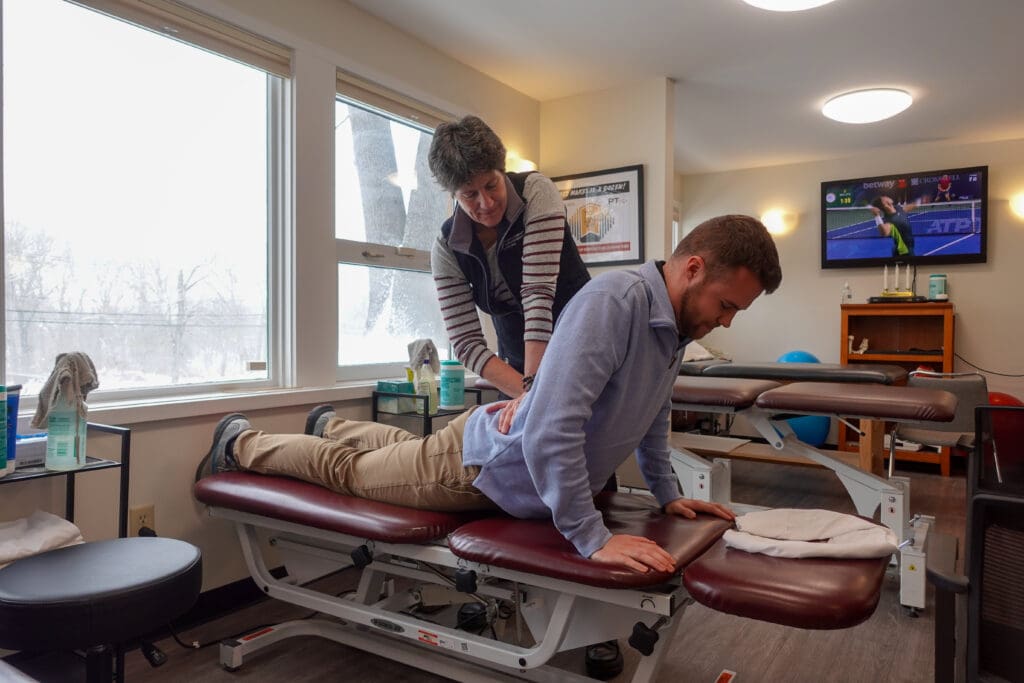 Treatment depends on the severity of the injury and symptoms. Many patients will see improvement over a few weeks, and many patients will be pain free after four months. However, patients may still experience bouts of lower back pain during recovery. One or two days of rest should help relieve initial pain, but patients should not stay in bed for longer and should limit long periods of sitting. If you are already an active person, you can continue doing activities that do not increase pain, but you should modify your return to focus on slow controlled motions and limit lifting heavy weight. You may also want to avoid motions that involve bending forward and lifting. However, you should only avoid certain movements altogether for a short amount of time. The goal is to get back to your normal movement patterns as quickly and as best you can.
Treatment depends on the severity of the injury and symptoms. Many patients will see improvement over a few weeks, and many patients will be pain free after four months. However, patients may still experience bouts of lower back pain during recovery. One or two days of rest should help relieve initial pain, but patients should not stay in bed for longer and should limit long periods of sitting. If you are already an active person, you can continue doing activities that do not increase pain, but you should modify your return to focus on slow controlled motions and limit lifting heavy weight. You may also want to avoid motions that involve bending forward and lifting. However, you should only avoid certain movements altogether for a short amount of time. The goal is to get back to your normal movement patterns as quickly and as best you can.
NSAIDs can help relieve pain. Some patients may benefit from an epidural steroid injection to reduce inflammation and provide short-term relief. Many patients do not even need this cortisone-like medicine.
Very few patients will require surgery, and it is often only for patients who have not seen relief after conservative treatment.
Physical therapy will often be prescribed to patients with a herniated disc to help strengthen the core and surrounding muscles. Physical therapists can also diagnose a herniated disc by performing a variety of tests.
The great news is that exercise can help move the disc back to its original position! The key is to take exercises to end-range. One great exercise is cobra pose. You might not be able to get into the end-range position when you start but keep gently stretching until you are able to tolerate the end-range position.
Exercises to do while experiencing a herniated disc:
- Prone on elbows with progression to Cobra Pose
- Pelvic tilts
- Deep core activation exercises, such as the McGill crunch
Exercise to limit while experiencing a herniated disc:
- Intense workouts such as HIIT or running
- Heavy lifting, especially hinge movements like deadlift variations
This is general advice. Some people with a h
erniated disc can continue their exercise routines as they normally would or with slight modifications. A physical therapist can help you structure your exercise routine to help you heal and continue doing the activities you love.
3. SI Joint Pain
The Sacroiliac (SI) joint is located at the junction of the sacrum and the ilium. The SI joint is essential for shock absorption and stability, and it works in functions including walking, standing, sitting, and getting up and down. There are a few different causes of SI joint pain, including sprain, strain, dysfunction, and sacroiliitis. Sacroiliitis is inflammation of the SI joint that can be caused by traumatic injury, overuse, or underlying issues such as arthritis or autoimmune diseases.
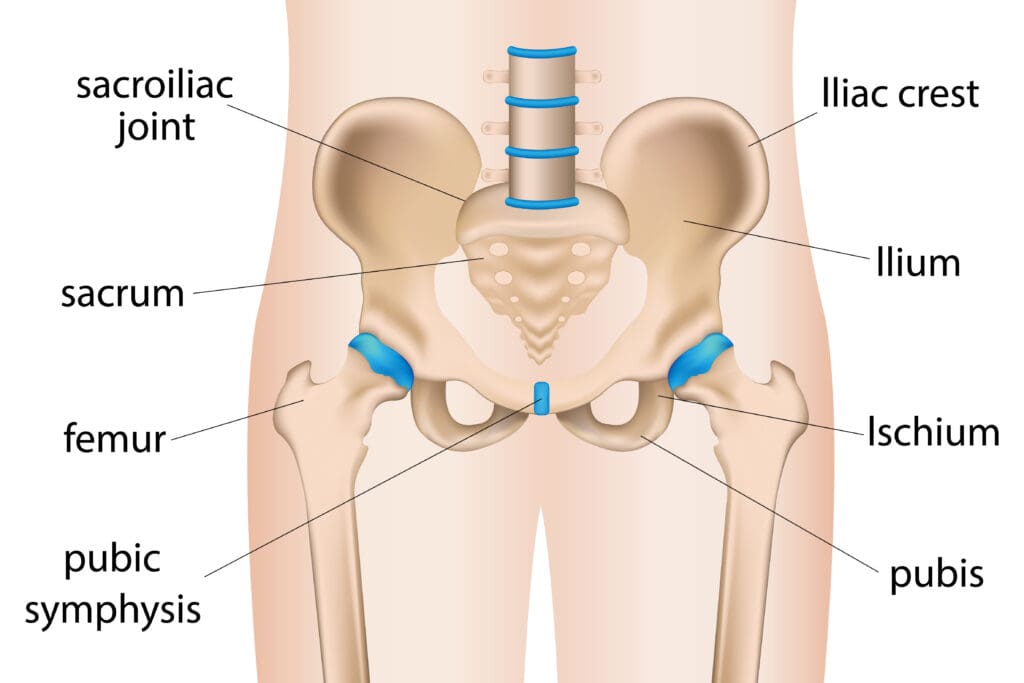
Signs and Symptoms
SI joint dysfunction symptoms can be similar to other causes of back pain. It’s important to get an accurate diagnosis to treat the condition properly.
- Pain in the low back and/or buttocks
- Low back pain on one side (can also be on both sides, but it’s more frequently on one side
- Pain that worsens with sitting, standing, sleeping, or walking
- Reduced mobility in low back and legs
- Stiffness in the low back and hips, especially after periods of inactivity
Treatment
Physical therapy treatment for SI joint pain will vary by patient, and may include strengthening the muscles in the low back, abdomen, pelvis, and thigh to improve function. Physical therapists will also address flexibility, which can help to improve or maintain joint mobility, improve posture, and increase range of motion. Physical therapists might also use manual therapy, a technique in which the therapist uses their hands to mobilize soft tissue, to help reduce inflammation. As long as symptoms are not severe, patients with SI joint dysfunction should be able to continue their normal routine, while focusing on flexibility, posture, proper form, and core engagement.
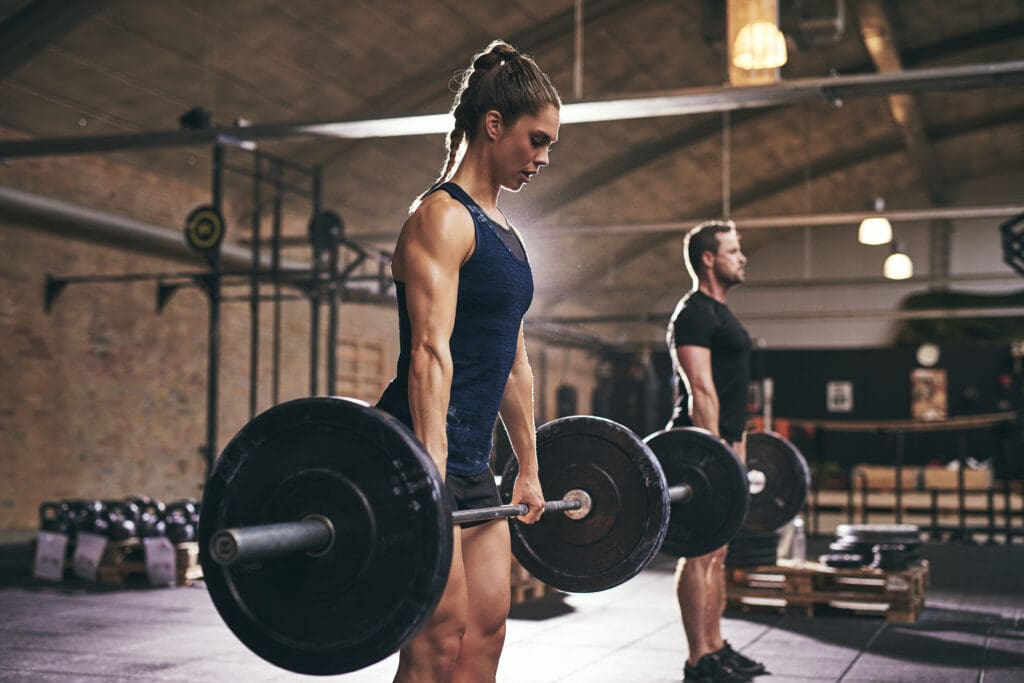
Chronic Pain
Do you always feel low back pain after deadlift days? It might not be intense and could go away after a couple of days, but it’s noticeable. Low back pain is so common these days, partly because of our sedentary society. Here are some lifestyle factors that might be causing chronic low back pain, and what you can do to help resolve it. Again, pain is complex. You might not be able to pinpoint one specific cause, and there might not be one magic cure.
Sedentary lifestyle – Let’s be honest. A one-hour workout a day does not make up for eight hours of consistent sitting. Our bodies are made to move! Try to get up every hour and take some steps or do some gentle stretching. You’ll feel better mentally and physically when you give yourself those breaks.
Posture – Did you immediately sit or stand up straighter when you read that word? Consistent poor posture could be causing you back pain. It’s especially easy to have bad posture in a sitting position. In this position, the hip flexors are in a shortened position. If you don’t get up and stretch out, your hip flexors might be become tight from staying in this position. It’s also easy to slouch, which puts pressure on your low back and other areas of your body. You might also cross your legs frequently, which can lead to pain. It takes time and awareness to fix your posture, but it’s worth the effort!
Strength and Mobility Deficits or Imbalances – Even if you work out every day and are on an advanced training program, you still might have imbalances or deficits that could cause pain. Most lifters have one body part they love training. Do you always look forward to back day or leg day? It can be hard to look at ourselves and see the holes in our training program, especially if you’ve been training for a while. Some common strength deficits that might cause low back pain include:
- Weak core
- Weak glutes
- Weak upper back muscles such as the rhomboids
Mobility deficits are even harder to uncover. Do you have a dedicated mobility or stretching routine? It’s really tempting to do your workout and skip mobility drills, but it’s essential to keep you lifting properly and limiting pain. Some common mobility deficits that might cause low back pain:
- Limited hip mobility
- Limited thoracic spine mobility
Why does mobility matter? Let’s use deadlifting and tight hips as an example. Your hips are working to move from hip flexion into extension. If the hips are unable to complete the full range of motion, the low back may compensate. That means- you’re trying to work your hips but you’re accidentally working your low back. Not good!
Some great mobility exercises that you can do every day:
- World’s greatest stretch
- Thoracic spine rotation
- Frog pose
Underlying conditions – Underlying conditions may cause or increase back pain. Some conditions that may cause back pain include:
- Arthritis
- kidney/GI/urinary disease/symptoms
- Osteoporosis
Remember that back pain is common and more often than not, the result of a musculoskeletal injury. Just because you have back pain does not mean you have an underlying condition. It’s important for your physical therapist to understand your underlying conditions in order to treat your back pain appropriately.
The bottom line
Back pain is so common these days that many just live with it and chalk it up to the aging experience. You do NOT have to live with back pain, even if it feels manageable or goes away after a couple of days or with medications.
Your physical therapist will consider your lifestyle, symptoms, and goals in order to create a program to relieve your back pain and allow you to continue working out!
